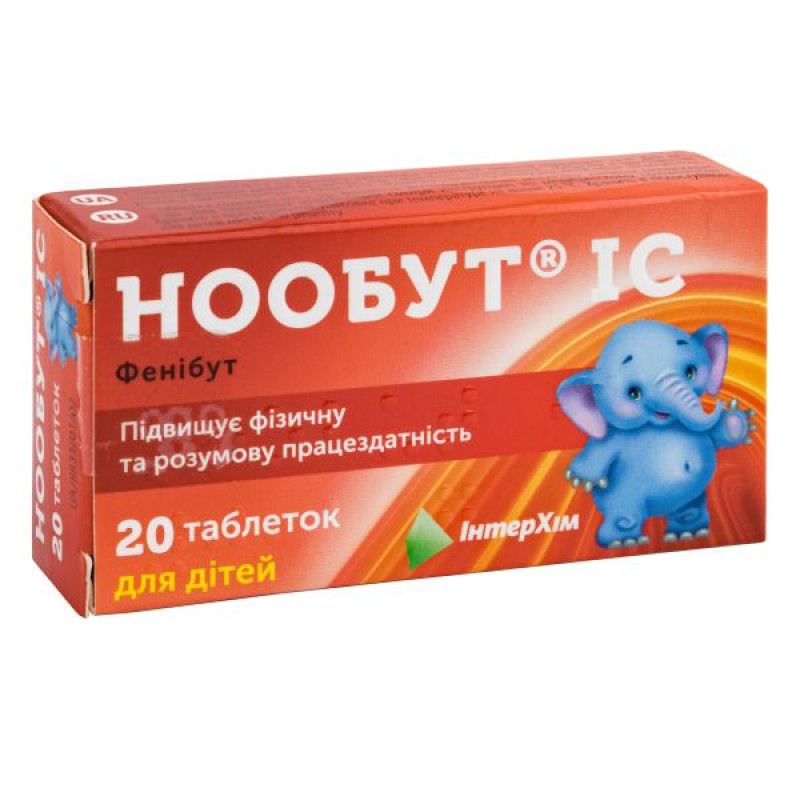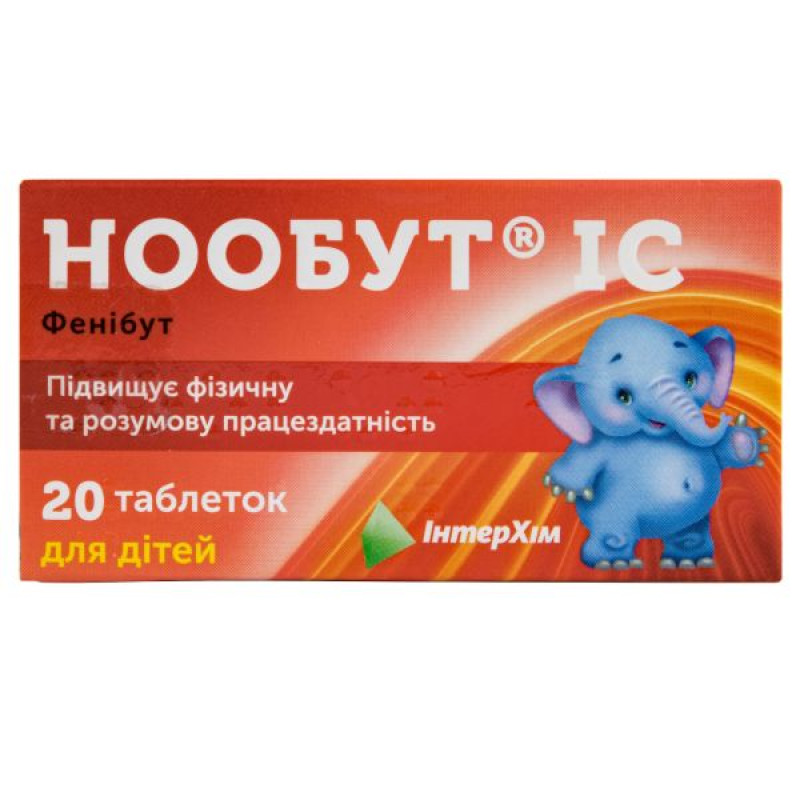Noobut IC tablets 0.1 g No. 20

Instructions for Noobut IC tablets 0.1 g No. 20
Composition
active ingredient: phenibut;
1 tablet contains 100 mg (0.1 g) or 250 mg (0.25 g) of phenibut;
Excipients: lactose monohydrate, potato starch, povidone, calcium stearate.
Dosage form
Pills.
Main physicochemical properties: tablets of white or white with a yellowish tint, flat-cylindrical shape, with a bevel; on one surface of the tablet there is a trademark of the company, on the other surface of the tablet there is a line.
Pharmacotherapeutic group
Psychostimulants, drugs used for attention deficit hyperactivity disorder (ADHD), and nootropics. Other psychostimulants and nootropics. Phenibut.
ATX code N06B X22.
Pharmacological properties
Pharmacodynamics.
Phenibut is a derivative of γ-aminobutyric acid (GABA) and phenylethylamine. Its dominant action is antihypoxic and antiamnestic. The drug Noobut® IC improves memory and attention, promoting learning processes, and increases physical and mental performance. Psychological indicators (speed and accuracy of sensory-motor reactions) under the influence of the drug improve. It has been established that phenibut improves brain bioenergetics, increasing the energy potential of neurons by improving mitochondrial functions.
Also, the drug Noobut® IS has the properties of a tranquilizer: it eliminates psycho-emotional tension, feelings of anxiety, fear, emotional lability, irritability, and improves sleep. Phenibut binds in the brain exclusively to GABA receptors, therefore it has a moderate sedative effect, but does not cause undesirable sedative effects: drowsiness, dizziness, decreased attention and performance. The drug prolongs the latent period and reduces the duration and severity of nystagmus, has an antiepileptic effect. It does not affect cholinergic and adrenoreceptors.
The drug Noobut® IS significantly reduces the manifestations of asthenia and vasovegetative symptoms, including headache, feeling of heaviness in the head. In patients with asthenia and in emotionally labile individuals, when using phenibut, the well-being improves without excitement from the first days of therapy.
Pharmacokinetics.
Phenibut is well absorbed after oral administration and penetrates well into all tissues of the body, passes well through the blood-brain barrier (about 0.1% of the administered dose of phenibut penetrates into brain tissue, and in young and elderly people it is much higher). The greatest binding of phenibut occurs in the liver (80%), it is non-specific. Distribution in the liver and kidneys is close to uniform, and in the brain and blood - less uniform.
80-95% of phenibut is metabolized in the liver, the metabolites are pharmacologically inactive.
After 3 hours, a significant amount of the administered phenibut is detected in the urine, while the concentration of phenibut in the brain tissues does not decrease, it is detected in the brain after another 6 hours. The next day, phenibut can only be detected in the urine; it is detected in the urine for another 2 days after administration, but the detected amount is only 5% of the administered dose. With repeated administration, cumulation is not observed.
Indication
Asthenic and anxiety-neurotic conditions (emotional lability, memory impairment, decreased concentration), feelings of restlessness, fear, anxiety, obsessive-compulsive neurosis.
Insomnia, night restlessness in elderly patients.
Prevention of stressful conditions before surgeries or painful diagnostic examinations.
Meniere's disease, dizziness associated with dysfunction of the vestibular analyzer of various origins.
Prevention of motion sickness (a specific condition characterized by nausea, vomiting, prostration, and vestibular dysfunction caused by being in a moving object, such as a ship or airplane).
Stuttering, enuresis, tics in children aged 3 to 14 years.
As an adjunct in the treatment of alcohol withdrawal syndrome.
Contraindication
Hypersensitivity to any component of the drug. Acute renal failure. Pregnancy or breastfeeding.
Interaction with other medicinal products and other types of interactions
The drug Noobut® IC can be combined with other psychotropic drugs, reducing the doses of the drug Noobut® IC and the concomitantly used drugs.
The drug Noobut® IS enhances and prolongs the effect of hypnotics, narcotics, neuroleptics, and anti-Parkinsonian drugs.
Application features
Patients with gastrointestinal disorders should be cautious when using Noobut® IC due to the irritating effect of phenibut. Such patients should use lower doses of the drug or take the drug after meals.
In case of prolonged use, blood cell counts and liver function tests should be monitored.
The medicinal product contains lactose, therefore it should not be used in patients with rare hereditary forms of galactose intolerance, lactase deficiency or glucose-galactose malabsorption syndrome.
Use during pregnancy or breastfeeding
Animal studies have not revealed any mutagenic, teratogenic or embryotoxic effects of phenibut. Adequate and well-controlled studies of the safety of phenibut in women during pregnancy or breastfeeding have not been conducted. Therefore, the use of Noobut® IC during pregnancy or breastfeeding is contraindicated.
Ability to influence reaction speed when driving vehicles or other mechanisms
Patients who experience drowsiness, dizziness, or other central nervous system disturbances during treatment with phenibut should refrain from driving or operating other machinery.
Method of administration and doses
The drug should be taken orally. Swallow the tablet whole with a sufficient amount of water. In order to reduce the irritating effect of phenibut on the gastrointestinal tract (see the section "Special instructions"), the drug can be taken after meals.
Adults
Asthenic and anxiety-neurotic conditions
The drug should be used at a dose of 250−500 mg 3 times a day.
Maximum single dose: for adults – 750 mg, for elderly patients – 500 mg.
The course of treatment is 2-3 weeks. If necessary, the course of treatment can be extended to 4-6 weeks.
Meniere's disease and dizziness associated with vestibular dysfunction of various origins
For the treatment of dizziness associated with dysfunction of the vestibular analyzer of infectious origin, and in Meniere's disease during the exacerbation period, the drug is used at 750 mg 3 times a day for 5-7 days, with a decrease in the severity of vestibular disorders - 250-500 mg 3 times a day for 5-7 days, and then 250 mg 1 time a day for 5 days. With a relatively mild course of the disease, the drug is used at 250 mg 2 times a day for 5-7 days, and then 250 mg 1 time a day for 7-10 days.
For the treatment of dizziness due to dysfunction of the vestibular analyzer of vascular and traumatic origin, the drug should be used at a dose of 250 mg 3 times a day for 12 days.
Prevention of motion sickness
The drug should be administered at a dose of 250-500 mg once 1 hour before the expected onset of dizziness or at the first symptoms of dizziness.
As part of complex therapy for alcohol withdrawal syndrome
In the first days of therapy, the drug should be used at 250-500 mg 3 times during the day and 750 mg at night, with a gradual decrease in the daily dose to the usual adult dose.
Patients with hepatic insufficiency
High doses of the drug may be hepatotoxic in patients with hepatic impairment. Lower doses should be used in this group of patients.
Patients with renal insufficiency
There are no data on the adverse effects of the drug on patients with renal insufficiency when using therapeutic doses.
Children
| Child's age | Dosage regimen | Maximum single dose |
| 3–4 years | 100 mg 2 times a day | 100 mg |
| 5–6 years | 100 mg 3 times a day | 100 mg |
| 7–10 years | 200 mg 2 times a day | 200 mg |
| 11–14 years old | 200 mg 3 times a day | 300 mg |
The course of treatment is 2−6 weeks.
To prevent motion sickness, take a single dose of Noobut® IC 1 hour before traveling by sea, land, or air.
The drug Noobut® IC can be combined with psychotropic drugs, which increases its effectiveness (see the section “Interaction with other drugs and other types of interactions”).
The development of drug dependence and withdrawal syndrome when using phenibut was not observed.
Isolated cases of tolerance to phenibut have been reported in the literature.
If one or more doses have been missed, the medication should be continued at the previously prescribed doses. If you feel unwell, you should consult a doctor.
Children.
The medicine can be used in children aged 3 to 14 years.
Overdose
There are no data on overdose. Noobut® IC is a low-toxic drug, only in a daily dose of 7–14 g in case of prolonged use it can be hepatotoxic. These doses significantly exceed the recommended average therapeutic doses, according to the patient's age.
Symptoms: drowsiness, nausea, vomiting, dizziness.
With prolonged use of high doses of phenibut, the development of arterial hypotension, acute renal failure, eosinophilia, and fatty liver disease is possible.
Treatment: gastric lavage. Symptomatic therapy.
There is no specific antidote.
Side effects
Like all medicines, Noobut® IS can cause side effects, although not everybody gets them.
Nervous system: frequency unknown - drowsiness (at the beginning of treatment), headache, dizziness (in the case of doses above 2000 mg per day, the severity of the side effect decreases with a decrease in the dose).
Mental disorders: frequency unknown - emotional lability, sleep disorders (these adverse reactions may be observed in children if the drug is used without following the recommendations of the instructions for medical use of the drug).
Gastrointestinal: frequency unknown - nausea (at the beginning of treatment), vomiting, diarrhea, epigastric pain.
Liver and biliary tract: frequency unknown - hepatotoxicity (with prolonged use of high doses).
Immune system disorders: frequency unknown - hypersensitivity reactions, including urticaria, erythema, angioedema, facial edema, tongue edema.
Skin and subcutaneous tissue disorders: rarely - allergic reactions (rash, itching).
If any adverse reactions occur, you should seek medical advice.
Expiration date
3 years.
Storage conditions
Store in the original packaging at a temperature not exceeding 25 °C.
Keep out of reach of children.
Packaging
10 tablets in a blister; 2 blisters in a pack.
Vacation category
According to the recipe.
Producer
Additional Liability Company "INTERCHEM".
Address
Ukraine, 65025, Odessa, 21st km. Starokyivska Road, 40-A.
There are no reviews for this product.
There are no reviews for this product, be the first to leave your review.
No questions about this product, be the first and ask your question.







